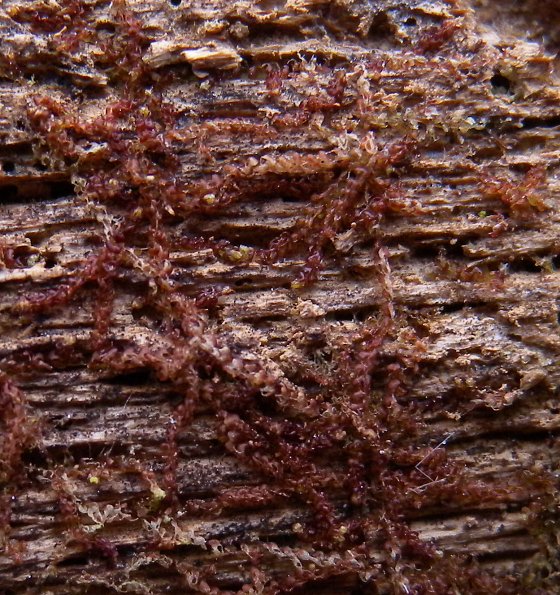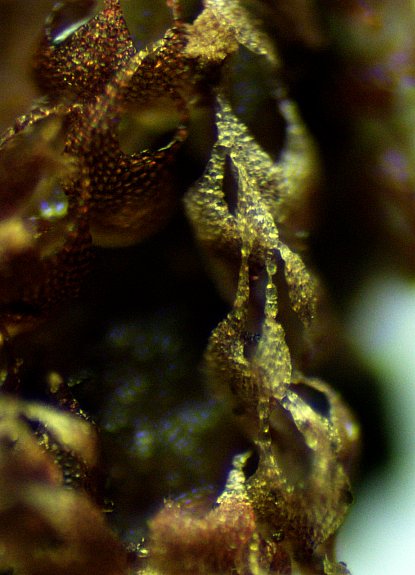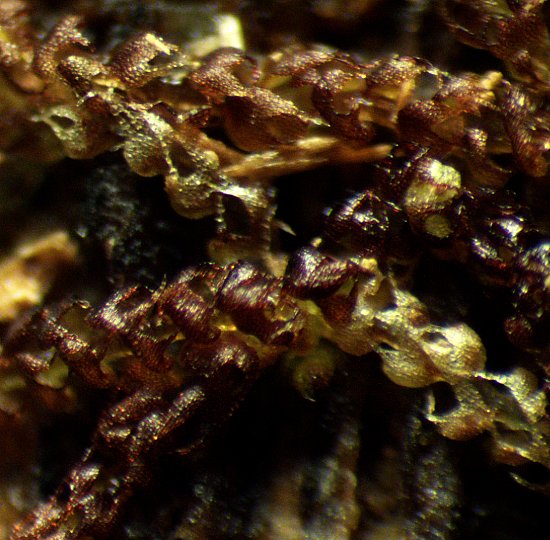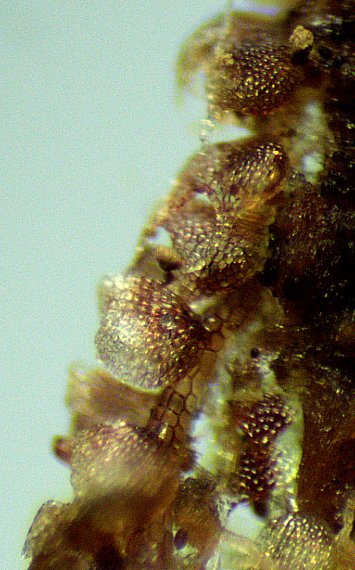
The translucent leaves are light green in shade and warm weather, but they become whitish red to dark red in sunlight or cold weather. The leaf cells are irregularly hexagonal throughout and they lack oil bodies. This leafy liverwort is usually dioecious (rarely monoecious), forming male reproductive organs (antheridia) and female reproductive organs (archegonia) on separate plants. Male reproductive organs occur underneath alternate leafy bracts on short lateral stems. These leafy bracts resemble the incurved bases of sterile leaves, except they lack the lobes of the latter. Female reproductive organs occur in solitary erect perianths at the ends of main stems. These perianths are about 1.5 mm. tall; they are cylindrical and 3-angled in shape. The perianths are smooth-angled, while their apices are short-fringed. They are usually reddish below and whitish above. Each perianth is preceded by about 2 pairs of leafy bracts; they are bilobed like the sterile leaves, except their lobes tend to be wider and they are larger in size overall; they are often fringed along their margins. The perianths normally develop during the autumn.

After fertilization occurs, small spore-bearing capsules on erect or ascending stalks develop during the spring. The capsules are ovoid-oblongoid in shape and black or brown, while their stalks are translucent white and terete. After a period of development lasting about 2 weeks, these capsules divide into 4 parts to release their tiny spores to the wind. Sometimes this leafy liverwort also produces erect stems that have gemmae (clonal buds) along the margins of their leaves. These modified leaves are less than 0.5 mm. long and about one-half as much across; they are oval-shaped and lack the lobes of leaves on sterile shoots. The tiny gemmae are single-celled, ovoid in shape, and clear-translucent to yellowish green. After the gemmae become detached from these modified leaves, they are capable of developing into new plants. This leafy liverwort is anchored to its substrate by fibrous rhizoids that occur sparingly along the bottoms of the stems.
Cultivation: The preference is dappled sunlight to medium shade, damp humid conditions, and a location that is protected from the wind. This plant strongly prefers to grow on barkless rotting logs, although it has been known to colonize sandstone, humus, sand, or other substrates on rare occasions.

Range & Habitat: The native Rustwort (Nowellia curvifolia) is uncommon in southern Illinois, while in the rest of the state it is rare or absent (see Distribution Map). This leafy liverwort is widely distributed in eastern North America; it also occurs in Eurasia and Central America. Habitats include decorticated (barkless) logs in woodlands, especially where streams and vernal pools occur. Other habitats include decorticated logs in rocky hollows and canyons, and moist sandstone rocks in wooded areas. In Illinois, Rustwort occurs primarily on the decorticated logs of deciduous trees, but outside of the state it often occurs on the decorticated logs of coniferous trees. This leafy liverwort is normally found in higher quality natural areas.
Faunal Associations: No information about floral-faunal relationships for this species is currently available.
Photographic Location: A decorticated (barkless) log near a pool of water in Busey Woods at Urbana, Illinois. Close-up photos where taken indoors with a microscope.

Comments: The leafy stems of this little plant are almost cylindrical in appearance because of its strongly curved leaves. They resemble miniature chains of leaves or corkscrew-shaped streamers. Because of its strongly curved leaves and their long slender lobes, Rustwort (Nowellia curvifolia) is one of the easiest leafy liverworts to identify. Its closest relatives in Illinois are probably pincerwort species (Cephalozia spp.), which are also often found on logs. While pincerwort species also have leaves with pairs of tapered lobes, the lobes of Rustwort are longer and more slender. The leaves of pincerwort species, like their stems, lie flat against the underlying substrate, while the leaves of Rustwort are strongly curved, especially at their bases. Because Rustwort's leaf bases are folded inward to form open pouches, they are capable of holding more water. This enables it to better withstand periods of drought. Unlike scalewort species (Frullania spp.) however, Rustwort lacks distinct lower lobes and it has no underleaves.